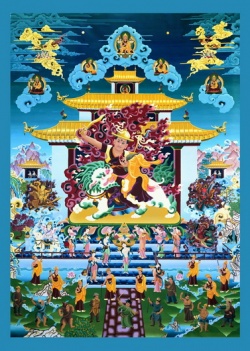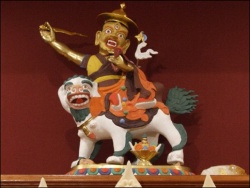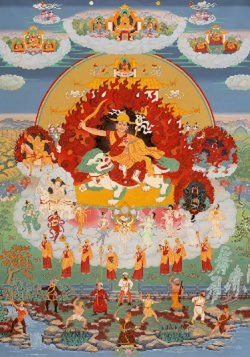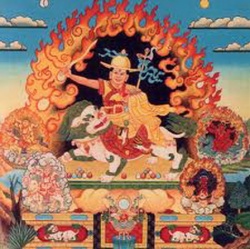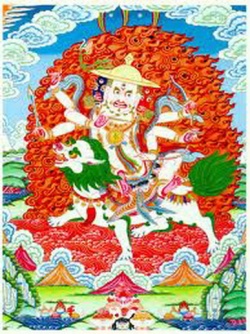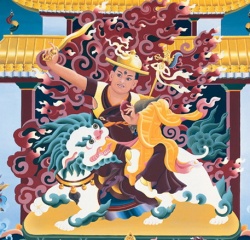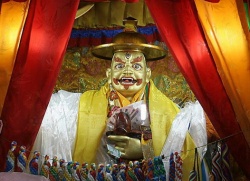Dorje Shugden
Dorje Shugden (Tibetan: རྡོ་རྗེ་ཤུགས་ལྡན, Wylie: rdo-rje shugs-ldan), "Vajra Possessing Strength", or Dolgyal Shugden (Tibetan: དོལ་རྒྱལ་ཤུགས་ལྡན, Wylie: dol rgyal shugs ldan), "Shugden, King of Dhol" is a deity (Tib. lha) in Tibetan Buddhism, especially its Gelug school, who is regarded as a Dharma Protector or "guardian angel." The practice of Dharma Protectors is central to most religious Tibetans and practitioners of Tibetan Buddhism.[6]
Dorje Shugden is regarded as the incarnation of Gelugpa Lama Dragpa Gyaltsen of Drepung Monastery, a contemporary of the Fifth Dalai Lama. Yet, Dorje Shugden's enlightened nature has been debated since his appearance in the 17th century.[8] With the current Dalai Lama's growing public opposition and subsequent "explicit ban" of the practice, this debate has escalated into what is known as the Dorje Shugden controversy.
Differing views
Ursula Bernis explains that "The different beliefs about Dorje Shugden depend not so much on historical records but on the differing interpretations of the relationship between reality and appearance." Thus, Dorje Shugden as a Dharma Protector has come to be understood in two ways:
A supramundane deity (Tib. 'jig rten las 'das pa'i srung ma)
A mundane deity (Tib. 'jig rten pa'i srung ma)
According to Trijang Rinpoche, these two seemingly contradictory views—Dorje Shugden as either an enlightened protector, or a worldly protector—are easily reconciled by the belief that Dorje Shugden "can appear in any mundane or supra-mundane form whatsoever depending upon whether our mind is pure or impure."
The Dalai Lama, however, accepts only that he is a worldly spirit, not an enlightened being :
Dorje Shugden is a protector spirit who has been worshiped for three hundred years, traditionally associated with the Sakya and Gelug traditions. However, even the major masters of the Eastern tradition take a very critical view of Shugden, seeing him as an evil spirit.
Thus, while supporters of Shugden identify him as an emanation of Buddha Manjushri, detractors classify him as a malevolent spirit (Tib. gyalpo). These two conflicting, disparate views are explained by Bernis as the very basis for the contemporary Dorje Shugden controversy.
Function as a Dharma Protector
Adherents of Dorje Shugden pray to him to protect their Dharma realizations of wisdom and compassion and gather all conducive conditions for their spiritual practice to succeed. According to von Brück, "He comes from all directions (and monasteries!) in order to protect his worshippers, to fulfill wishes, to purify the dharma, etc."
A common example of a prayer to Dorje Shugden, requesting him to fulfill these functions, is:
I beseech you from the depths of my heart, O Supreme Deity,
Please cause the tradition of Je Tsongkhapa to flourish,
Extend the life and activities of the glorious Gurus,
And increase the study and practice of Dharma within the Dharma communities. Please be with me always like the shadow of my body,
And grant me your unwavering care and protection.
Destroy all obstacles and adverse conditions,
Bestow favourable conditions, and fulfil all my wishes.... Through increasing the study, practice, pure discipline, and harmony
Of the communities who uphold the stainless doctrine of Buddha,
And who keep moral discipline with pure minds,
Please cause the Gedän tradition to increase like a waxing moon.
The practice starts with prayers to Buddha Shakyamuni, followed by prayers to Je Tsongkhapa (the founder of the Gelug tradition). Practitioners then meditate on Lamrim, Lojong and/or Mahamudra, concluding with prayers to Dorje Shugden to eliminate obstacles to (and create favorable conditions for) the flourishing of Dharma.
The most famous proponent and supporter of the practice of Dorje Shugden in the West, Geshe Kelsang Gyatso, explained how Dorje Shugden protects the tradition of Je Tsongkhapa in particular:
Dorje Shugdän is a Dharma Protector who is the manifestation of Je Tsongkhapa. Je Tsongkhapa appears as the Dharma Protector Dorje Shugdän to prevent his doctrine from degenerating. During his life, Je Tsongkhapa founded and established the doctrine of the Ganden oral lineage, which leads living beings to the attainment of permanent liberation from suffering and the supreme happiness of enlightenment very quickly. Of course, Je Tsongkhapa himself takes responsibility to prevent his doctrine from degenerating or from disappearing. He takes responsibility for his doctrine to remain from generation to generation. To do this, since he passed away he continually appears in many different aspects, such as in the aspect of a Spiritual Teacher, who teaches the instructions of the Ganden oral lineage.
According to some alive at the time, Dorje Shugden also protected the 14th Dalai Lama in his escape from Tibet to India. The monk Helmut Gassner, the Dalai Lama's German translator for 17 years, explains:
Another, particularly impressive figure of old Tibet was the Dalai Lama's Chamberlain, Kungo Phala, whom you may vividly remember seeing in the movie Kundun. He was a guest in my home in Feldkirch on several occasions. It was he who in 1959 organized His Holiness' escape from the Norbulingka summer palace. He sometimes spoke to me about it, perhaps because he was pleased with the progress I was making in my Tibetan language studies. The preparations for the escape were made in absolute secrecy and strictly followed instructions received from Dorje Shugden. I asked him what thoughts were on his mind when he had to make his way through the crowds surrounding the Norbulingka with the Dalai Lama, disguised as a servant, just behind him. He said that everything happened exactly as the Dorje Shugden oracle from Panglung Monastery had predicted. (Panglung Rinpoche now lives in Munich.) In particularly dangerous situations, he felt he was moving within a protected space, his feet seemingly not even touching the ground. I later heard many more accounts about the escape from other people who were personally involved in it, like Trijang Rinpoche's attendants and monks of Pomra Khamtsen of Sera Mey Monastery, who had been chosen as the Dalai Lama's personal bodyguards.
The 14th Dalai Lama himself used to be a practitioner of the Dharma Protector Dorje Shugden before considering him as an evil spirit. He composed the following prayer:
MELODY OF THE UNCEASING VAJRA
A Propitiation of Mighty Gyalchen Dorje Shugden,
Protector of Conqueror Manjusri Tsongkhapa’s Teachings
By the Supreme Victor, the Great 14th Dalai Lama HUM Glory of the wisdom, compassion and power of infinite Buddhas
Miraculously powerful protector of Manjusri Tsongkhapa’s Teachings
Arisen as a lord of all wrathful worldly hosts
Come from the abodes of Tushita, Kechara, and so forth! Prostrating with devotion of body, speech, and mind
I confess all mistakes and faults in which
Out of delusion, I have contradicted your holy mind:
Accept with forbearance and show your smiling face! Arising from the sport of non-dual bliss and void
Are offerings and torma of flesh and blood heaped like a mountain
First portions of milk, yogurt, beer and tea swirling like the ocean Auspicious signs and substances and various animals
Peaceful and wrathful ornaments, enemy-destroying weapons and armor
Amassed samaya substances, outer, inner, and secret, without exception! Having fulfilled your heart commitment and purified degeneration
By making these actually arranged and visualized offerings
Increase Lozang the Victorious One’s Teachings
And the life span and activities of the Teachings’ upholders!
Further the happiness of beings in the Gaden [Podrang] dominion! Especially pacify all harm to us, the yogis and entourages
That arises because of previous karma and immediate conditions
And spontaneously accomplish, just as we wish
All good things, both spiritual and temporal! Grind to dust without remainder
Enemy hordes that think and act perversely
Towards the teachings and lay and ordained people
With potent, accurate, powerful great vajra fire! Especially, cause the saffron-clad community of Dungkar Monastery
Brightly beautiful in bonds of pure morality
To soar the path of immortal liberation
On unified wings of Sutra and Tantra! In brief, we enthrone you, O Deity, as the supreme
Collected nature of all Gurus and Protective Deities!
From densely gathered clouds of the four activities
Pour down a cool rain of the two siddhis!
This, A Propitiation of Mighty Gyalchen Dorje Shugden, Protector of Conqueror Manjusri Tsongkhapa’s Teachings, entitled Melody of the Unceasing Vajra ’s composition was urged, not only by the vajra prophecy of the great emanated Dharmapala himself, but also on behalf of the general community by the master of the Dratsang and all of its officers, with offerings. Accordingly, the one called Holder Of The White Lotus, Bearer of the Buddhadharma, Ngawang Losang Tenzin Gyatso Sisum Wangyur Tsungpa Mepa De composed it at Dungkar Monastery with spontaneous auspiciousness. All benefit and bliss! Siddhi Rastu
Appearance and symbolism
The entry for Dorje Shugden in Frederick Bunce's encyclopedia of Buddhist entities describes Dorje Shugden's appearance as follows:
Face: one, fearsome, bared fangs, three bloodshot eyes, orange flame sprouts from eyebrows and facial hair, yellow brown hair stands on end, from his nostrils issue rain clouds with violent lightning; arms/hands: two, right hand holds flaming sword (khadga, ral-gri), left hand holds skull-cup (kapala, thod-pa) filled with the organs of the five senses, hearts, brains, and blood, in the crook of his left arm rests a mongoose (ichneumon or nakula, nehu-li) and golden goad/hook (ankusha, lcags-kyu); body: bejeweled, elephant skin upper garment, loin cloth of tiger skin; legs: two; ornaments: five-skull crown, wristlets, anklets, necklace, garland of fifty freshly severed heads, tiger or elephant skin as a body covering and apron of carved human bones; color: dark red; vahana: carpet of human skins on one hundred thousand thunderbolts (vajra, rdo-rje) on the back of a garuda-like bird (khyung); companion: include Zhi-ba'i-rgyal-chen, rGyas-pa'i-rgyal-chen, dBang-'dus-rgyal-chen, Drag-po'i-rgyal-chen.
All rituals and prayers related to Dorje Shugden refer to him as an enlightened Protector or holy being. For example, one sample prayer to him from the extensive fulfilling and restoring ritual (Tib. kangso) of Dorje Shugden:
You said "I will protect as a wealth of merit for all beings
The sublime, stainless essence of the Sugatas' teachings."
O Hero Manjushri and Yamantaka in a fearsome disguise,
With the strength of a million Dharma Protectors; to you we offer praise.
In regards to Dorje Shugden's "fearsome disguise" praised above, Bernis explains that this wrathful appearance is considered by practitioners to be "merely an external show to help those who are threatened or fearful." Von Brück describes Dorje Shugden's appearance as follows:
His character is fierce and violent and he destroys all enemies. Animals are sacrificed to him symbolically. His abode is full of skeletons and human skulls, weapons surround him and the blood of men and horses form a lake. His body has a dark-red colour and his facial expressions are similar to the well-known descriptions of rakshasas. However, all these attributes are not unique, they are more or less stereotypes for dharma-protectors in general.
According to some adherents, it is correct to consider Dorje Shugden as an emanation of Manjushri but not one who shows the aspect of a worldly being. The form of Dorje Shugden is supposed to reveal the complete stages of the path of Sutra and Tantra, and such qualities are not possessed by the forms of worldly beings. Dorje Shugden appears as a fully ordained monk to show that the practice of pure moral discipline is essential for those who wish to attain enlightenment. In his left hand, he holds a human heart to symbolize great compassion and spontaneous great bliss – the essence of all the stages of the vast path of Sutra and Tantra. His round yellow hat (Tib. sakshu) represents the view of Nagarjuna, and the wave-shaped sword (Tib. chula) in his right hand teaches us to sever ignorance, the root of samsara, with the sharp blade of wisdom (like the sword held aloft by Manjushri and Je Tsongkhapa). This is the essence of all the stages of the profound path of Sutra and Tantra. He rides a snow lion, symbolizing the four fearlessnesses of a Buddha. Geshe Kelsang suggests:
Even Dorje Shugden's form reveals the complete stages of the path of Sutra and Tantra, and such qualities are not possessed by the forms of worldly beings.
Retinue and mandala
Painting of Dorje Shugden, his mandala, and his retinue
One of the characteristics of the iconography of Dorje Shugden is the central figure surrounded by four cardinal emanations. According to Nebresky-Wojkowitz:
"In the East resides the 'body emanation' (sku'i sprul pa) Zhi ba'i rgyal chen, white with a mild expression" (Vairochana Shugden)
"In the South dwells 'emanation of excellence' (yon tan gyi sprul pa) rGyas pa'i chen." (Ratna Shugden)
"In the West dwells 'emanation of speech' (gsung gi sprul pa) dBang 'dus rgyal chen, of white colour, having a slightly wild expression." (Pema Shugden)
"In the North resides the 'emanation of karma' ('phrin gyi sprul pa) Drag po'i rgyal chen. His body is of a green colour, and he is in a ferocious mood." (Karma Shugden)
According to adherents, Dorje Shugden is the incarnation of the five Buddha families and appears in five forms that symbolize the five families, called 'the five lineages of Dorje Shugden'. These forms also symbolize Dorje Shugden's attainment of pacifying, increasing, controlling and wrathful actions and his main form as Duldzin symbolizes the supreme attainment of enlightenment itself.
According to Sachen Kunlo, a Sakya Lama, each of the thirty-two Deities of Dorje Shugden's mandala has a specific enlightened function: Duldzin Dorje Shugden leads followers to correct spiritual paths by bestowing wisdom; Vairochana Shugden helps pacify negative karma and obstacles; Ratna Shugden increases good fortune; Pema Shugden helps control the mind; and Karma Shugden overcomes the four maras and evil spirits. The nine great Mothers help Tantric practices; the eight fully ordained monks help Sutra practices; and the ten wrathful Deities help daily activities.
Unlike other Dharma protectors, the practice of Dorje Shugden has a body mandala. This is considered an indication that he is a fully enlightened being because only Buddhas have body mandalas. Dorje Shugden's body mandala is based on the 32 deities of Lama Losang Tubwang Dorjechang (Je Tsongkhapa).
Mantra
Dorje Shugden has two mantras: OM VAJRA WIKI WITRANA SOHA and OM DHARMAPALA MAHA RANDZA BENDZA BEGAWAN RUDRA PENJA KULA SARWA SHA TRUM MARAYA HUM PHAT.
The two mantras in Tibetan writing: ཨོཾ་བཛྲ་བི་ཀི་བིཊྞ་སྭཱཧཱ། and ཨོཾ་དྷརྨ་པཱ་ལ་མཧཱ་རཱ་ཛ་བཛྲ་བེ་ག་ཝན་རུ་དྲཿཔཉྩ་ཀཱུ་ལ་སརྦ་ཤ་ཏྲཱུཾ་མཱ་ར་ཡ་ཧཱུཾ་ཕཊ།
In the long mantra, OM DHARMAPALA MAHA RANDZA refers to Dorje Shugden's name: DHARMAPALA means "Dharma Protector," and MAHA RANDZA means "Great King." BENDZA BEGAWAN RUDRA means "Dorje Shugdan," and PENJA KULA SARWA SHA TRUM MARAYA HUM PHAT means “Please grant me attainments.”
In OM VAJRA WIKI WITRANA SOHA, OM refers to the outer aspect of Dorje Shugdan, which is his wearing ordained robes and so on and is temporary. One function of OM is also calling Dorje Shugdan “O, Dorje Shugdan”. VAJRA refers to the real nature of Dorje Shugdan. The meaning of VAJRA is the union of the great bliss and emptiness of Je Tsongkhapa and of all Buddhas. Je Tsongkhapa’s realization of the union of great bliss and emptiness appears in the aspect of Dorje Shugdan. The five Sanskrit letters WIKI WITRANA symbolize the five attainments: pacifying, increasing, controlling, wrathful and supreme. SOHA means "Please bestow." The whole mantra therefore means: “O Dorje Shugdan, please bestow the pacifying, increasing, controlling, wrathful, and supreme attainments.”
Origin story
Previous incarnations
According to his adherents, Dorje Shugden is the current incarnation in a lineage of enlightened Masters. The lineage of Dorje Shugden's previous lives includes Buddha Manjushri, Mahasiddha Biwawa or Virupa, Sakya Pandita, Butön Rinchen Drub, Duldzin Dragpa Gyaltsän, and Panchen Sönam Dragpa.
Dorje Shugden is said to have appeared in his current form as the reincarnation of a Buddhist Teacher in the Gelugpa Tradition named Ngatrul (Tulku) Dragpa Gyaltsen, the reincarnation of Panchen Sonam Dragpa. Dragpa Gyaltsen was a highly regarded teacher at the same time as the Fifth Dalai Lama, the former held by some in even higher regard than the latter.
Dorje Shugden is considered by some Gelugpa practitioners to be an emanation of Buddha Manjushri: "Because the lamas in Drakpa Gyaltsen's lineage of incarnations are manifestations of the wisdom Buddha Manjusri, and because Drakpa Gyaltsen appeared in the form of Dorje Shugden, we believe without doubt that the very nature of Dorje Shugden is that of a wisdom Buddha." This understanding is also based on the commentary to Dorje Shugden by Trijang Rinpoche:
[T]his great guardian of the teachings is well known to be the precious supreme emanation from Drepung monastery's upper house, Dragpa Gyaltsen, arising in a wrathful aspect. The proof is unmistaken. Tulku Dragpa Gyaltsen, as is taught in the lineage, was the final birth in a reincarnation lineage that included the Mahasiddha Birwawa, the great Kashmiri Pandit Shakya Shri, the omniscient Buton, Duldzin Dragpa Gyaltsen, Panchen Sonam Dragpa, and so forth; this is proven by valid scriptural quotation and reasoning. These great beings, from a definitive point of view, were already fully enlightened, and even to common appearances, every one of them was a holy being that attained high states of realization.
Also Ngulchu Dharmabhadra (1772–1851), a Mahamudra lineage Guru, identified Dorje Shugden as having arisen from the continuum of great beings that includes Duldzin Drakpa Gyaltsen, Panchen Sonam Drakpa and Tulku Drakpa Gyaltsen.
Death of Tulku Dragpa Gyaltsen and emergence of Dorje Shugden
The emergence of the practice is strongly related to Tulku Dragpa Gyaltsen, a contemporary of the 5th Dalai Lama about whom exist different stories. According to von Brück, there is little documented historical evidence before the beginning of the 19th century and different orally transmitted versions of his origins contradict each other.[46] von Brück traces the root of the link between the death of Tulku Drakpa Gyaltsen and the worship of Dorje Shugden back to "the power struggles of the 5th Dalai Lama and the successful centralization of power in his hands after the death of the Mongol Gushri Khan." ] According to Mullin, the soul of the murdered monk Dragpa Gyaltsen wandered after his death for some time as a disturbed spirit, who created trouble for the people of Lhasa. The 5th Dalai Lama tried to "exorcise and pacify" him by first asking Nyingma shamans to subdue him, but when they failed he asked Gelugpa shamans who were finally successful. By these measures, the spirit of the deceased Lama was "pacified and transformed" into the Dharma Protector Dorje Shugden. According to Mumford, the 5th Dalai Lama unsuccessfully tried to subjugate Dorje Shugden through a fire exorcism and "invited the still-wandering spirit to become a Srungma of the Gelugpa order, with result that Shugs-ldan became one of the most popular Srungmas in Tibet. With the encouragement of local Lamas, kin groups all over Tibet took on Shugs-ldan as their lineage guardian."
Mullin continues, saying that the practice was later adopted by "numerous Gelugpa monks who disapproved of the 5th Dalai Lama's manner of combining Gelugpa and Nyingmapa doctrines" and that the 5th Dalai Lama tried to discourage the practice, but "it caught on in many monasteries". According to Mullin, "The practice continued over the generations to follow, and eventually became one of the most popular Protector Deity practices within the Gelugpa school." The practice became even more popular during the late 1800s. During that time, Dorje Shugden "became an all pervasive monthly practice within almost all provincial Gelugpa monasteries, and was especially popular with Gelugpa aristocratic families."
According to Tagpo Kelsang Khedrub, although the Fifth Dalai Lama and others tried to destroy Dorje Shugden, they were not able to because Shugden is enlightened:
Then, although four undisputed powerful Tantrikas with concentration, began wrathful rituals to strike you down, through the power of having completed Guhyasamaja's two stages, you would not be silenced, and showed signs of heroism; praise to you!
According to some Gelug Lamas, there is evidence to show that the 5th Dalai Lama realized he was mistaken in considering Dorje Shugden a spirit, and then composed a prayer praising Dorje Shugden as a Buddha and crafted a statue[52] to show his respect for Dorje Shugden. Concerning whether the 5th Dalai Lama composed a prayer to Dorje Shugden, the 14th Dalai Lama said that "it is difficult for us to prove convincingly whether it belongs to the Fifth Dalai Lama or not."[53] Michael von Brück denies the historical evidence of such a claim, stating "The problem is that this position has no historical evidence, neither in the biography of the 5th Dalai Lama or elsewhere," adding that for this reason the authenticity of the oral tradition cannot be decided.
According to McCune, the story about his being a wandering spirit was said by followers to be disseminated by those who murdered Tulku Dragpa Gyaltsen, not by his followers who viewed him as the reincarnation of a highly realized being. [verification needed]
Oracle
As with other Protector Deities in Tibet, there is an oracle of Dorje Shugden.[56] A previous medium of contact with Shugden has been Trode Khangsar Kuten.
According to Nebesky-Wojkowitz, "The best-known of the prophetic seers who act as the mouthpiece of rDo rje shugs ldan lives at a shrine in Lhasa called sPro bde khang gsar Trode Khangsar (rgyal khang) or sPro khang bde chen lcog. This is one of the few Tibetan oracle-priests who is not allowed to marry. In a house close to this shrine stays also one of the most renowned mediums of Kha che dmar po.
According to Joseph Rock there were two main Dorje Shugden oracles: Panglung Choje and Trode Khangsar Choje. Joseph Rock witnessed and documented a public invocation of the Panglung oracle in Kham (Eastern Tibet) in 1928. At this time the oracle took a sword of Mongolian steel and twisted into many loops. Choyang Duldzin Kuten Lama was the Dorje Shugden oracle for many years.
Dharmapala
Manjushri
Dorje Shugden controversy
Further reading
Heart Jewel: The Essential Practices of Kadampa Buddhism, Tharpa Publications (2nd. ed., 1997) ISBN 978-0-948006-56-2
Rinpoche, Chogyal Namkhai Norbu (2005). "Provocations of the Gyalpo" (HTML). Merigar Dzogchen Community, Italy. Retrieved 2012-11-21.
Bernis, Ursula (PDF). Condemned to Silence: A Tibetan Identity Crisis (1996-1999). Retrieved 2009-10-25.
Shugden Society, Western (January 2010). A Great Deception. ISBN 978-0-9563918-0-3.
Birgit Zotz, Zur europäischen Wahrnehmung von Besessenheitsphänomenen und Orakelwesen in Tibet. Vienna University 2010 .
